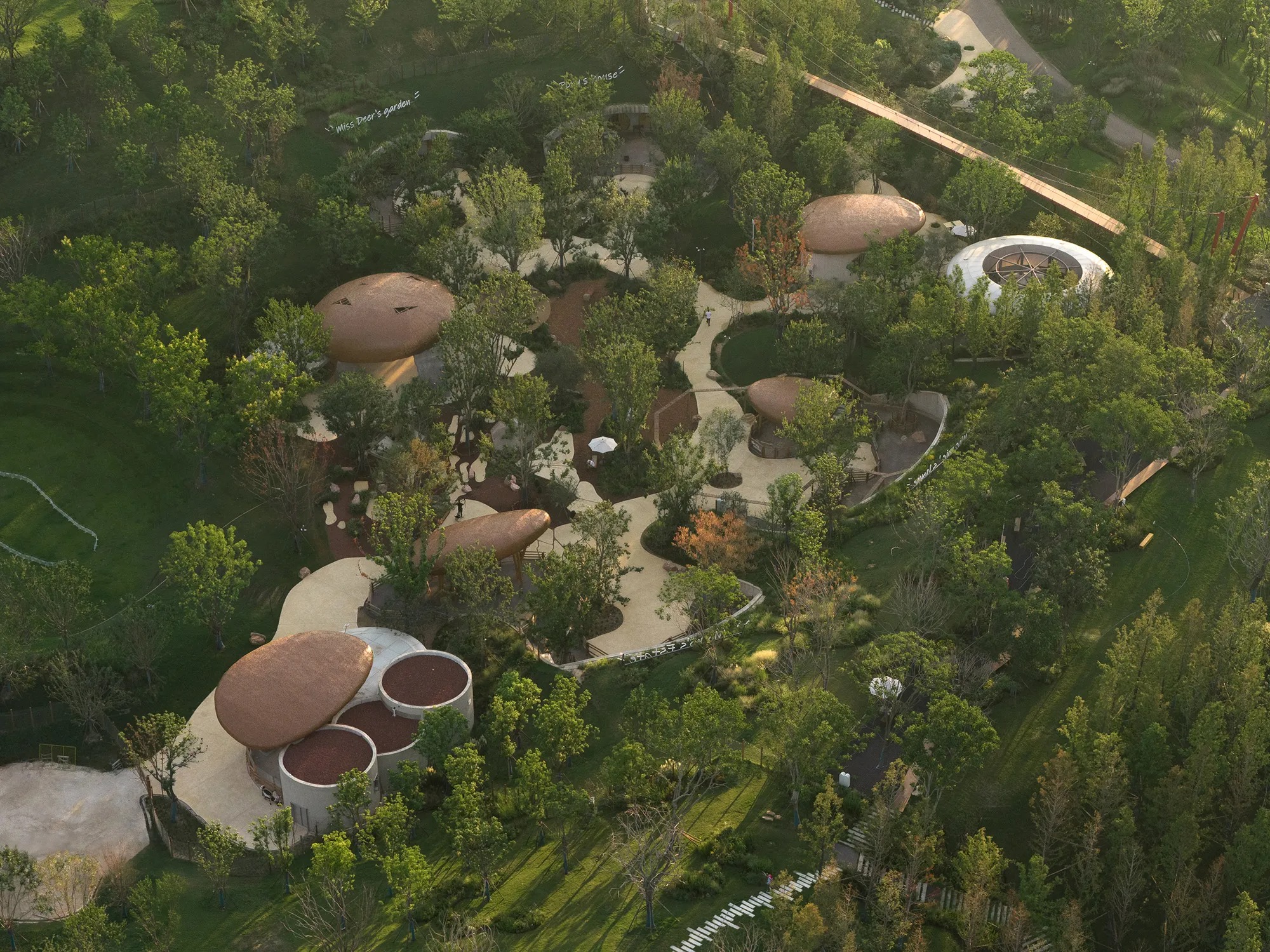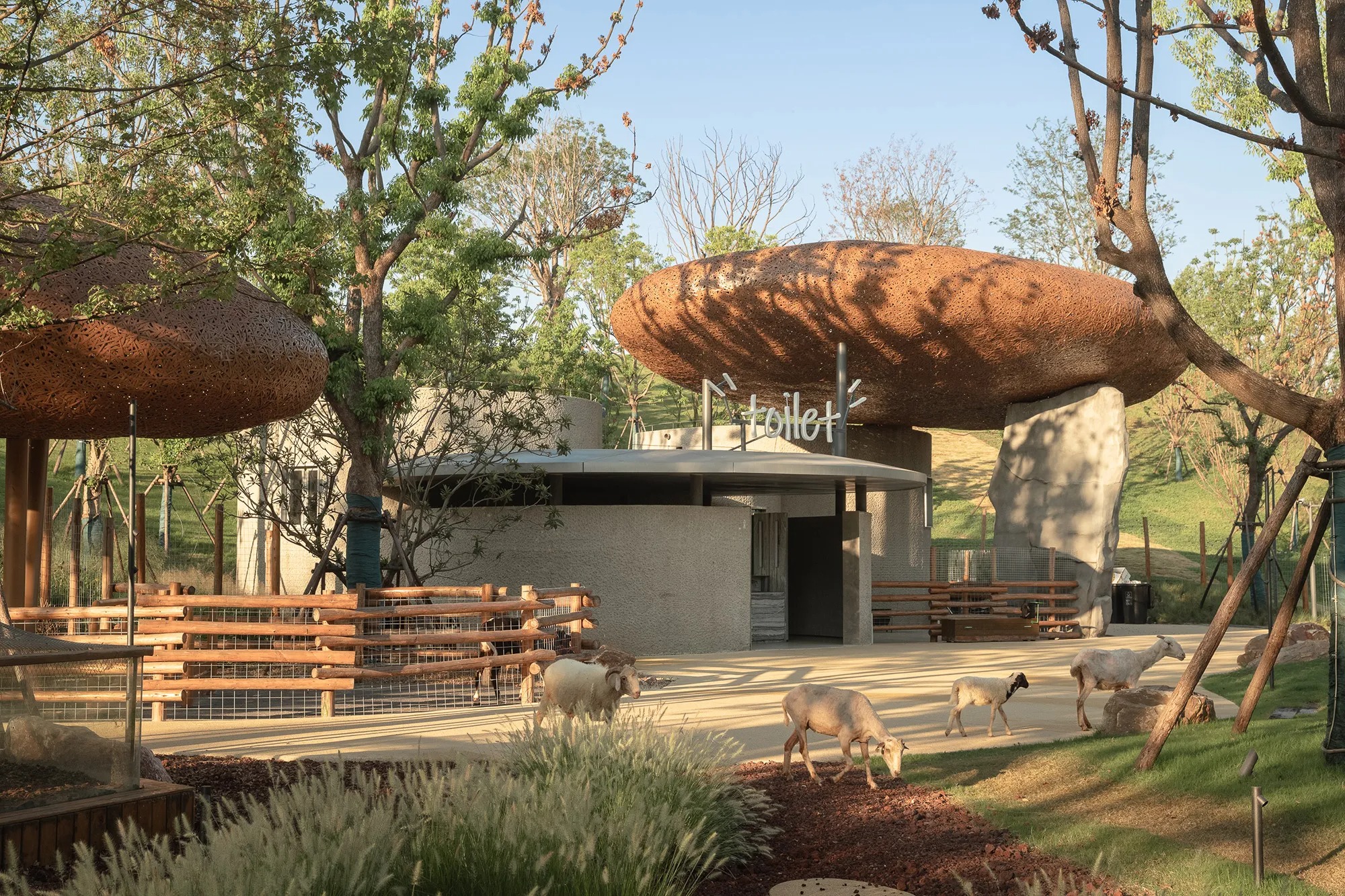"건축은 땅에서 자라나야 한다. 그곳에 속하고, 그 풍경을 장식해야 한다."- 프랭크 로이드 라이트

 |
 |
 |
우한 맥시아일랜드 농장: 땅과 하나 되는 대나무 직조의 생태 농장 Various Associates-LuxeIsland Farm in Wuhan: Bamboo-Woven Eco-Tourism Park
Various Associates, 주자강변에 펼쳐낸 지형의 건축
우한의 맥시아일랜드 농장은 주자강을 따라 펼쳐진 소규모 농업 공원이다. Various Associates는 지형을 따르는 전략을 택한다. 작은 건물들을 경사면에 반쯤 묻고, 초록 지붕을 목초지로 이어지게 한다. 순환 동선이 동물 우리, 열린 공방, 작은 음식 파빌리온을 엮어낸다. 대나무를 엮은 캐노피와 돌처럼 둥근 건물들이 계곡의 일부처럼 읽힌다. 절제된 금속 랜드마크가 방향을 안내하되, 장소의 연속성을 깨뜨리지 않는다.
지형을 읽는 계획과 순환의 흐름
계획안은 순환 동선을 만든다. 이 동선은 동물 구역, 공방, 작은 매점을 하나로 꿴다. 걷는 동안 열림과 머무름이 교차하는 흐름이 만들어진다. 시선이 트이고 좁혀지기를 반복하며 동물과 풍경을 마주하는 순간이 이어진다. 동선은 기존 지형을 존중한다. 입구는 평평한 땅에 두고, 완만한 경사를 따라 계곡 바닥을 가로질러 강을 향한 전망이 펼쳐지도록 안내한다.
새로운 건물들은 부분적으로 땅 속에 묻힌다. 경사면이 초록 지붕 위로 이어져 건물의 존재감을 줄인다. 동물 우리는 둔덕에 파고들어 울타리와 차단막을 최소화하거나 지형 속으로 흡수시킨다. 목장을 계단식으로 조성해 길과 서식지 사이의 시선을 유지한다. 바위처럼 둥근 형태가 낮은 수평선을 유지하고, 나무 캐노피와 풀이 주도하게 한다. 일관된 시각 리듬이 사물의 집합이 아닌 지형처럼 보이게 만든다.
길 찾기는 표지판이 아닌 순서에 의존한다. 순환 동선은 그늘진 문턱과 서비스 지점으로 나뉘며 움직임의 쉼표를 만든다. 자갈, 모래, 목재 데크로 이루어진 일관된 바닥 전략이 구역을 전환한다. 파빌리온 근처의 높은 보행량과 동물 경계의 부드러운 바닥재를 수용한다. 동선은 투과성을 유지하되, 명시적인 장벽보다는 지형의 높낮이 차이와 식재 밀도를 통해 안전한 분리를 확보한다.
구축 방식과 재료의 이중 언어
프로젝트는 두 가지 재료 레지스터를 정렬한다. 가벼운 직조 표면과 무거운 돌 같은 볼륨이다. 대나무와 목재가 기후와 빛을 조절하는 상부 요소를 형성하고, 낮은 벽과 기둥형 지지대는 광물적 표현을 택한다. 이 조합은 지면에서 구조를 안정시키면서 상부의 경량감을 유지한다. 작은 파빌리온이 시각적 부담 없이 날씨와 마모를 견뎌야 하는 상황에 유용한 전략이다.
대나무 엮기는 장식 레이어가 아닌 건축 시스템으로 다뤄진다. 돔형과 떠 있는 지붕에 구멍을 뚫어 투과성 있는 천장을 만든다. 햇빛을 거르고 열을 배출한다. 삼각형 개구부가 바닥과 좌석 위로 얼룩진 빛을 흩뿌린다. 엮인 두께는 더욱 견고한 하부 구조 위에서 통기성 있는 그늘 어셈블리로 작동한다. 일관된 직조와 돌 질감의 기둥이 결합되어 프로그램 유형 전반에 걸쳐 인식 가능한 구축 언어를 확립한다.
금속 요소는 공간 신호로 절제해 사용한다. 은빛 디스크 키오스크와 캔틸레버 캐노피는 반사되고 매끄러운 마감을 택한다. 주로 흙빛 팔레트 안에서 밝은 길 찾기 표지로 기능한다. 절제된 대비가 계곡을 가로질러 방향을 안내하고, 조용한 서식지와 서비스 지점을 구별하되 전체 재료의 연속성을 지배하지 않는다.
프로그램의 생태와 인간-동물의 접점
동물 구역은 서식지와 적절한 거리감을 결합한다. 열린 목장, 모래 구덩이, 그늘진 목재 프레임워크가 동물에게 다양한 바닥재와 은신처를 제공하면서 방문자는 가까이 다가서되 적절한 시선을 유지한다. 경사면을 따라 흙으로 덮인 은신처가 열 안정성을 개선하고 보호 공간을 형성한다. 낮은 난간과 식재가 경계를 정의하되 울타리가 아닌 땅의 형태로 읽힌다.
공방은 투과성 있는 사교 거점으로 작동한다. 큰 가동식 파사드가 식재된 마당으로 열리며 공예 시연, 비공식 교육, 휴식이 목초지 경계로 흘러나간다. 대나무로 엮은 돔이 낮 동안 빛을 조절하고 저녁 모임을 수용한다. 내부 조명이 밝혀지면 명암이 반전되어 캐노피가 랜턴이 된다.
서비스 구조물은 같은 구축 언어를 유지한다. 사료 창고와 화장실은 떠 있는 대나무-금속 지붕과 돌 질감의 기초를 택한다. 내부는 내구성과 청소 용이성을 위해 시멘트 코팅과 질감 타일을 사용한다. 뒷공간 기능을 공공 표현과 정렬함으로써 프로젝트는 전형적인 서비스-공공 영역의 단절을 피하고 순환 동선 주변의 프로그램 명료성을 유지한다.
Write by Claude & Jean Browwn



































LuxeIsland Farm in Wuhan develops a compact agricultural park along the Zhujia River through a terrain led strategy that embeds small buildings into slopes and extends green roofs into the pasture. Various Associates orchestrates a legible pedestrian loop that links animal enclosures, an open workshop, and compact food pavilions. The result is a low-profile ensemble of bamboo-woven canopies and stone-like volumes that read as part of the valley, using calibrated metal landmarks to guide orientation without disrupting the site’s continuity.
Terrain-Responsive Planning and Circulation
The plan adopts a closed loop that threads together animal zones, a creative workshop, and small concessions, creating a walkable gradient of exposure and rest. Sightlines open and compress along the loop to frame recurring moments of encounter with animals and landscape. The routing respects existing contours, placing entries on flatter land and using gentle inclines to choreograph views across the valley floor toward the river.
New volumes are partially earth sheltered, with the slopes extended over green roofs to reduce their apparent mass. Enclosures tuck into berms so that fencing and barriers are minimized or absorbed into landform, while graded paddocks step down to maintain clear sightlines between paths and habitats. Boulder-like profiles maintain a low horizon, allowing the tree canopies and grasses to dominate, and reinforce a steady visual cadence that reads as terrain rather than object collection.
Wayfinding relies on sequence rather than signage. The loop is punctuated by shaded thresholds and service stops that register as pauses in movement. A consistent ground strategy of gravel, sand, and timber decks transitions between zones, accommodating high foot traffic near pavilions and softer substrates at the animal edges. The circulation remains porous, yet maintains a safe separation through topographic differentials and planting density rather than overt barricades.
Tectonics and Material Language
The project aligns two material registers: lightweight woven surfaces and heavier, stone like volumes. Bamboo and timber form the upper elements that modulate climate and light, while low walls and columnar supports adopt a mineral expression. This pairing stabilizes the structures at ground while preserving lightness overhead, a useful strategy for small pavilions that must withstand weather and wear without visual bulk.
Bamboo weaving is treated as an architectural system rather than a decorative layer. Domed and floating roofs with perforations create a porous ceiling that filters daylight and vents heat. Triangular apertures scatter dappled light across floors and seating, and the woven thickness acts as a breathable shade assembly above more robust substructures. The consistency of the weave, combined with stone textured columns, establishes a recognizable tectonic language across program types.
Metallic elements are used sparingly as spatial beacons. A silver disc kiosk and a cantilevered canopy adopt reflective and smooth finishes, registering as bright wayfinding markers within the predominantly earthy palette. Their calibrated contrast aids orientation across the valley and differentiates service points from quieter habitats without dominating the overall material continuity.
Programmatic Ecology and Human–Animal Interfaces
The animal areas combine habitat and measured proximity. Open paddocks, sand pits, and shaded timber frameworks provide animals with varied substrate and shelter while allowing visitors close yet controlled views. Earth-covered shelters along slopes improve thermal stability and form protective retreats, with low parapets and planting defining edges that read as landform rather than enclosure.
The creative workshop operates as a porous social hub. Large operable façades open to a planted courtyard, allowing craft demonstrations, informal education, and rest to spill into the pasture edge. The bamboo woven dome tempers light for daytime use while accommodating evening gatherings when interior illumination reverses the figure-ground and the canopy becomes a lantern.
Service structures reinforce the same tectonic language for coherence. The feed barn and washroom adopt floating bamboo-and-metal roofs with stone textured bases, while interiors use cementitious coatings and textured tiles for durability and easy cleaning. By aligning back-of-house functions with the public expression, the project avoids the typical service-to-public rupture and maintains program clarity around the loop.
from archeyes